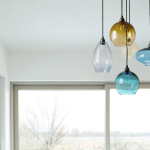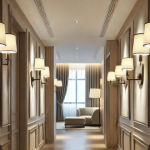Introduction
Wabi Sabi is a Japanese aesthetic concept that celebrates the beauty of imperfection and transience. It values simplicity, natural materials, and the imperfect beauty that comes from age and wear. Wabi Sabi has influenced many fields of design, including architecture, pottery, and interior design. In recent years, Wabi Sabi has also inspired lighting design, with Wabi Sabi light fixtures becoming increasingly popular. In this article, we will explore the beauty and appeal of Wabi Sabi light fixtures and how they can bring a sense of harmony and tranquility to our homes.
What are Wabi Sabi Light Fixtures?
Wabi Sabi light fixtures embody the principles of Wabi Sabi design. They are often made from natural materials such as wood, stone, or clay, and their designs embrace the rustic and imperfect beauty of these materials. Wabi Sabi light fixtures often have a weathered or aged appearance, which gives them a sense of history and character. They may be handmade or produced in small batches, adding to their uniqueness and individuality.
The Appeal of Wabi Sabi Light Fixtures
Wabi Sabi light fixtures have a unique appeal that sets them apart from other lighting designs. Their natural materials and textures create a warm, soothing ambiance that is both calming and inviting. The irregular shapes and forms of Wabi Sabi light fixtures also add a sense of visual interest and depth to a space.
Additionally, the Wabi Sabi philosophy values simplicity and minimalism, which is reflected in the design of the fixtures. Wabi Sabi light fixtures are often uncomplicated in their design, with clean lines and a focus on the natural beauty of the materials. This minimalist design approach can help create a more peaceful and relaxing environment in your home.
How to Incorporate Wabi Sabi Light Fixtures into Your Home
There are several ways you can incorporate Wabi Sabi light fixtures into your home. One approach is to use them as accent pieces, choosing one or two fixtures to highlight a specific area or feature of your home. For example, you could use a Wabi Sabi pendant light above your dining table to create a warm and inviting atmosphere for meals.
Another approach is to use Wabi Sabi light fixtures throughout your home. By selecting a consistent material or form, such as a series of wooden pendant lights, you can create a cohesive design theme that ties your home together. This approach works particularly well in open-concept spaces where a unified design approach can help create a sense of flow and harmony.
Caring for Wabi Sabi Light Fixtures
Wabi Sabi light fixtures are often made from natural materials and can be vulnerable to damage if not cared for properly. Here are some tips to help you care for your Wabi Sabi light fixtures:
Cleaning:
Avoid using harsh chemicals or cleaners on Wabi Sabi light fixtures, as these can damage the natural materials. Instead, use a soft cloth or brush to gently remove any dust or dirt.
Handling:
Wabi Sabi light fixtures may be delicate, so handle them with care. When installing or adjusting the fixtures, use caution to avoid damaging them.
Maintenance:
If your Wabi Sabi light fixtures are made from wood, stone, or other natural materials, they may require occasional maintenance to keep them looking their best. This may include applying a protective coating, such as wax or oil, to the surface to prevent damage from moisture or wear.
Conclusion
Wabi Sabi light fixtures offer a unique and beautiful approach to lighting design. Embracing the natural imperfections and beauty of the materials, Wabi Sabi light fixtures can create a sense of harmony and tranquility in your home. By incorporating these fixtures into your home, you can create a warm, inviting atmosphere that celebrates the beauty of simplicity and natural materials. With proper care and maintenance, your Wabi Sabi light fixtures can be enjoyed for years to come.







